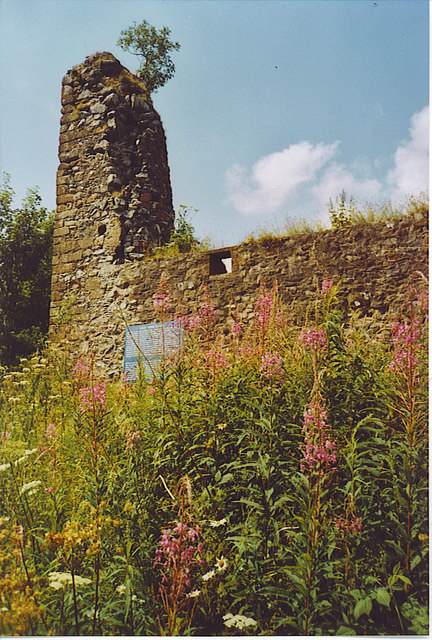Clan Maxwell Society
MAXWELL — JOHNSTONE FEUD

America’s most historic feud, the Hatfield and McCoy saga which decades in eastern Kentucky, looks somewhat like a Sunday afternoon picnic when compared to the Maxwell family’s legendary feud with its Scottish borderland neighbors, the Johnstones. The feud lasted about a century, reached out to include many other families of the region, and brought the deaths of key members of both the Maxwells and the Johnstones.
The Johnstones and Maxwells competed for primacy in the Scottish borderland throughout the 16th century, with the chiefs of each family serving at various times as Wardens of the West March. It was an era in which reiving and fighting were parts of everyday life, and conflict between these two strong families produced fodder for songs and poems as well as for the history books.
The feud had smouldered for decades with periodic episodes of violence, but it burst into full flame early in the 1590s when a Johnstone reiver known as the Galliard stole a horse from the Crichtons of Sanquhar Castle. Unfortunately for the Galliard, he stole the wrong horse and wound up escaping on an old, blind nag instead of the swift mare he had expected. The Crichtons easily caught him, and he was lynched from a nearby tree. That aroused the Johnstones, because the Galliard was a favorite among his clan, and they killed more than a dozen men while rampaging through Nithsdale in retribution.
When the Nithsdale lairds petitioned King James VI for justice, he ordered Lord Maxwell, Warden of the Scottish West March, to lead an expedition to punish the Johnstones. Although Lord Maxwell was reluctant to end the uneasy peace which had developed between the two families and rekindle the feud, he assembled 2,000 armed horsemen late in 1593 and, displaying the King’s banner, invaded the mountainous district of Annandale, land of the Johnstones.
According to legend, Lord Maxwell offered a grant of £10 of land to anyone bringing him the head or hand of the Laird of Johnstone — and that Johnstone reciprocated by offering a land bounty for Lord Maxwell’s head or hand. Johnstone raised a force of about 800, and they met Maxwell’s forces on December 6, 1593 near Lockerbie at a place called Dryfe Sands. Sir James Johnstone kept most of his men hidden and sent a handful of horsemen to provoke the Maxwell vanguard and then retreat. When the vanguard broke ranks to pursue the Johnstone horsemen, Johnstone’s hidden forces charged and caught the Maxwells off guard. It was a disaster for Maxwell, as his terror-stricken troops fled. The Johnstones savagely pursued their enemies into the streets of Lockerbie and into the Water of Dryfe, slaughtering some 700 and slashing others with downward sword strokes which caused gruesome facial wounds known as “Lockerbie licks.” And Lord Maxwell begged for mercy and offered to surrender, but the Johnstones cut off his outstretched arm and killed him instead.
Sir James Johnstone was proclaimed a rebel for his actions, but he managed to escape punishment, and he regained royal favor several years later when the King needed his help in ruling the border. The next Lord Maxwell was not quite as quick to forgive as the King, however; he grew up vengeful and unforgiving, leading several devastating raids against the Johnstones. His reiver-style attacks resulted in his being imprisoned in Edinburgh Castle several times, but he always managed to escape.
In 1608, a meeting was arranged to reconcile the differences between the two families. Sir James Johnstone met the new Lord Maxwell, son of the chief who was killed at Dryfe Sands, in a meeting “under trust.” Each chief brought only one additional clansman, and the two retainers withdrew a short distance to let the chiefs talk privately. But when the retainers began to argue, Johnstone went to break up the argument, and Lord Maxwell seized the opportunity to draw a pistol from under his cloak and shoot Johnstone in the back with two poisoned bullets. Maxwell had exacted retribution for his father’s death, but killing Johnstone “under trust” made him an outlaw.
Lord Maxwell escaped to France, and remained in Europe until 1612. He then returned to Scotland in hopes that his crime would be forgiven, but King James refused his plea for clemency. Pursued into the far north by his enemies, he was betrayed by a close kinsman, the Earl of Caithness, before he could get a ship back to Europe. He was publicly beheaded in Edinburgh, and that effectively ended the longstanding feud between the Maxwells and the Johnstones.
The ancient feud passed into history about the same time as the old Border Reiver ways, replaced by more peaceful times but preserved forever in such legends and songs as Lord Maxwell’s Last Goodnight.
Pictured are the remains of Lochwood Tower, a Johnstone stronghold destroyed by Maxwells during the long feud. When Robert Maxwell set the tower ablaze late in the 16th century, he was reported to have said it was “to give Dame Johnstone the light to set her silken hood by.”